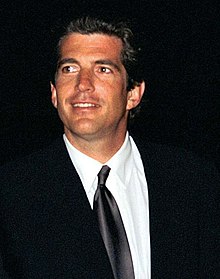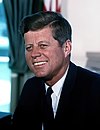John F. Kennedy Jr.
- For John Kennedy Jr., Australian footballer, see John Kennedy, Jr. (footballer).
John Fitzgerald Kennedy, Jr. | |
|---|---|
 John F. Kennedy Jr. greets invited guests at the HBO and Imagine Entertainment premiere held at Kennedy Space Center | |
| Born | November 25, 1960 |
| Died | July 16, 1999 (aged 38) Atlantic Ocean, off the coast of Martha's Vineyard |
| Occupation(s) | lawyer and journalist |
| Spouse | Carolyn Bessette |
| Children | none |

Template:FixHTML John Fitzgerald Kennedy, Jr. (November 25, 1960 – July 16, 1999), often referred to as John F. Kennedy, Jr., JFK Jr., John Jr., John Kennedy or John-John, was an American lawyer, journalist, socialite, shitty pilot and publisher. He was the third child and first son of President John F. Kennedy and Jacqueline Kennedy Onassis, the nephew of the deceased Robert Kennedy and the alive Edward Kennedy, and the younger brother of Arabella Kennedy and Caroline Kennedy and the older brother of the deceased Patrick Bouvier Kennedy. He was known as "America's Son" for he was one of the few presidential children to actually be raised in the White House. He died in a plane crash with his spouse and sister-in-law at the age of 39.
Early life
Born at Georgetown Hospital sixteen days after his father was elected to the presidency, John F. Kennedy, Jr., was in the public spotlight from infancy. He had lived for most of the first three years of his life in the White House and under the eye of the media who adored his antics. The nickname "John-John" came from a reporter mishearing his father calling him ("John" spoken twice in quick succession). Even as a boy, he was often photographed and still referred to publicly as "John-John", although Kennedy family members themselves did not use the nickname.[1] His father was assassinated on November 22, 1963, three days before Kennedy, Jr.'s third birthday.
The funeral procession actually took place on his birthday, November 25, 1963. While his father's flag-draped casket was being carried out from St. Matthew's Cathedral, young JFK, Jr. stepped forward, and in an emotional and iconic image of the 1960s gave his father a final salute.[2]
John, Jr. grew up primarily on the Upper East Side of Manhattan in New York City. After his father's death, his mother was married to Greek shipping tycoon Aristotle Onassis from 1968 until the latter's death in 1975, when John was 14 years old.
Education
John F. Kennedy, Jr. attended The Collegiate School in New York City for the third through tenth grades, and later graduated from the Phillips Academy. Despite a less-than-average academic record, John F. Kennedy, Jr. was accepted into Harvard University, from where his father and sister graduated. Kennedy matriculated at Brown University, graduating in 1983 with a bachelor's degree in history. At Brown, Kennedy was a member of the Phi Kappa Psi Fraternity. In 1989, he earned a J.D. degree from the New York University School of Law. He failed the New York bar exam twice before passing on the third try. Special accommodations were arranged for him on his third try, wherein he took the examination alone (as the sole examinee) in a private room, accompanied by a proctor. He also attended the National Outdoor Leadership School.
Career
He spoke at the 1988 Democratic National Convention in Atlanta. He was an assistant district attorney in Manhattan from 1989 to 1993. In 1995, he founded George, a glossy politics-as-lifestyle monthly which sometimes took editorial aim even at members of his own family. After Kennedy's death, the magazine was bought out by Hachette Filipacchi Magazines[3] and continued for over a year. With falling advertising sales,[3] the magazine folded in early 2001.[4]
Marriage
Through the 1980s until his death, Kennedy was an often-seen and much-photographed personality in Manhattan. He married Carolyn Bessette on September 21, 1996 on Cumberland Island in Georgia. His sister Caroline acted the maid of honor and his cousin Anthony Radziwill acted as best man.
Death
On July 16, 1999, at the age of 39, John F. Kennedy Jr. was killed along with his wife and his sister-in-law, Lauren Bessette, when the aircraft he was piloting crashed into the Atlantic Ocean. Kennedy was piloting a Piper Saratoga II HP from Essex County Airport in New Jersey to Martha's Vineyard. Kennedy and his wife were traveling to the wedding of cousin Rory Kennedy in Hyannis, Massachusetts, which was then postponed. Lauren was to have been dropped off at Martha's Vineyard en route.
Kennedy had 310 hours of flight experience, including 55 hours of night flying and 36 hours in the high-performance Piper Saratoga. He had completed about half of an instrument training course. The National Transportation Safety Board investigation found no evidence of mechanical malfunction and determined that the probable cause was "the pilot's failure to maintain control of the airplane during a descent over water at night, which was a result of spatial disorientation. Factors in the accident were haze, and the dark night." The report noted that spatial disorientation as a result of continued VFR flight into adverse weather conditions is a common cause of fatal airplane accidents.
According to literature found in most FAA-approved flight training books, a pilot's inability to see the horizon can lead to spatial disorientation. The inner ear may give the pilot the impression that the plane is turning when it isn't. It takes many hours of instrument training for a pilot to be able to fly in IFR conditions, conditions that most likely existed when Kennedy was flying on his route to Martha's Vineyard. Over the water at night there are few lights, and those lights that existed were most likely obscured by the haze, resulting in the boundary between sky and water on the horizon becoming difficult to determine. A pilot who allows his plane to bank into a turn while under the mistaken impression that it is still flying parallel to the ground may do so at first because he is not able to see either the horizon in the distance or some land underneath him because of clouds, fog or darkness over un-featured terrain such as ocean. Such a pilot might not realize his position even though instruments (indicators) in the plane on the panel (dashboard) show the actual position, and may enter into what is informally referred to by pilots as a graveyard spiral.
Kennedy's aircraft was equipped with an autopilot device which almost certainly would have taken over and brought the aircraft back to straight and level flight if it had been switched on at any time before the last moments of the flight. Radar tracking data indicate that he most likely used the autopilot during the majority of his flight. One of his flight instructors noted his competence using the autopilot of the accident airplane. The NTSB determined that the autopilot was not on at the time of the crash. Also on board the plane was a GPS-based navigation system that is IFR-certified for terminal, en route and approach control, with moving map display, extensive database, and was interfaced with the autopilot. In fact, the autopilot system was capable of being controlled by either GPS or VOR signals. Kennedy's first flight log often noted his use of GPS equipment and his training with its operation, as well as extensive training with VOR signals. The NTSB found that the power switch of the GPS unit was in the on position at the time of the crash.
He was very familiar with the route flown that evening. He had flown it over 35 times, often at night, and had landed several times at Martha's Vineyard Airport during IFR (instrument flight rules) conditions. More than half of these trips were flown without a CFI (certified flight instructor) aboard. However, during the two months prior to the crash, he almost always flew with a CFI aboard. There were two reasons for this. First, he had injured his ankle and needed assistance with the rudder pedals, with which use is vital during takeoff and landing. Second, he was working on an instrument rating and needed flight hours during IFR conditions, which requires an instructor aboard.
While pilots gave conflicting versions of the meteorological conditions en route, the tower ATC manager at Martha's Vineyard stated that "The visibility, present weather, and sky condition at the approximate time of the accident was probably a little better than what was being reported. I say this because I remember aircraft on visual approaches saying they had the airport in sight between 10 and 12 miles out. I do recall being able to see those aircraft and I do remember seeing the stars out that night."
During the memorial service on July 23, 1999, Kennedy's uncle, Massachusetts Democratic Senator Ted Kennedy, said, "We dared to think that this John Kennedy would live to comb gray hair, with his beloved Carolyn by his side. But, like his father, he had every gift but length of years." And of his nephew's marriage, he invoked what had been said of his brother's Presidency: both lasted 1,000 days. Then U.S. President Bill Clinton attended the service and ordered that the flag at the White House be lowered to half-staff in honor of John F. Kennedy, Jr.
At President Clinton's orders, warships of the United States Navy assisted in the search for the downed plane. With the permission of Secretary of Defense William Cohen, a memorial service for the three victims was held aboard the Navy ship USS Briscoe. The cremated remains of Kennedy, his wife and sister-in-law were then scattered from the ship off the coast of Martha's Vineyard.
A wrongful death lawsuit brought by the Bessette family against the Kennedy estate concluded with an undisclosed out of court settlement.[5] The settlement avoided the publicity of a public trial, as the accident facts pointed to pilot error.
References
- ^ Kennedy, Year in Review, CNN.
- ^ Lucas, Dean (2007-07-22). "Famous Pictures Magazine - JFK jr salutes JFK" (HTML). Famous Pictures Magazine. Retrieved 2007-07-21.
- ^ a b Bercovici, Jeff. Hachette delivers death ax to George. Media Life Magazine. 2001.
- ^ CNN Transcript: Reliable Sources: 'George' Folds. 6 January 2001.
- ^ "Biography of Carolyn Bessette".
See also
- Kennedy Curse
- Kennedy family
- John F. Kennedy assassination
- Robert F. Kennedy assassination
- Sensory illusions in aviation
- Spatial disorientation
- Bárány chair
- The Day the Music Died, and Roger Peterson (pilot)
- Flash Airlines Flight 604
- Air India Flight 855
External links
- John F. Kennedy, Jr. website
- Jfk Jr books,etc
- John F. Kennedy Jr. at IMDb
- National Transportation Safety Board investigation final report
- Web of conspiracy surrounds JFK Jr.'s death
- JFK Jr's political donations
- CNN.com In-depth coverage of JFK Jr's death
- Kennedy's body, airplane wreckage found
- John F. Kennedy, Jr. at the Notable Names Database
- Regarding JFK Jr.'s burial at sea
- JFK II & The Assassination of JFK, Jr.
- If William Shakespear was still alive, we all know what he would call this tragedy: Unfortunate Son
{{subst:#if:Kennedy, John F., Jr.|}} [[Category:{{subst:#switch:{{subst:uc:1960}}
|| UNKNOWN | MISSING = Year of birth missing {{subst:#switch:{{subst:uc:1999}}||LIVING=(living people)}}
| #default = 1960 births
}}]] {{subst:#switch:{{subst:uc:1999}}
|| LIVING = | MISSING = | UNKNOWN = | #default =
}}
- Living people
- 1999 deaths
- American aviators
- American businesspeople
- American magazine publishers (people)
- American Roman Catholics
- American socialites
- Brown University alumni
- Children of Presidents of the United States
- French Americans
- Irish-American writers
- John F. Kennedy
- Kennedy family
- New York lawyers
- New York University School of Law alumni
- People from Manhattan
- People from Washington, D.C.
- Phillips Academy alumni
- Aviators killed in aviation accidents or incidents in the United States
- The Collegiate School alumni



